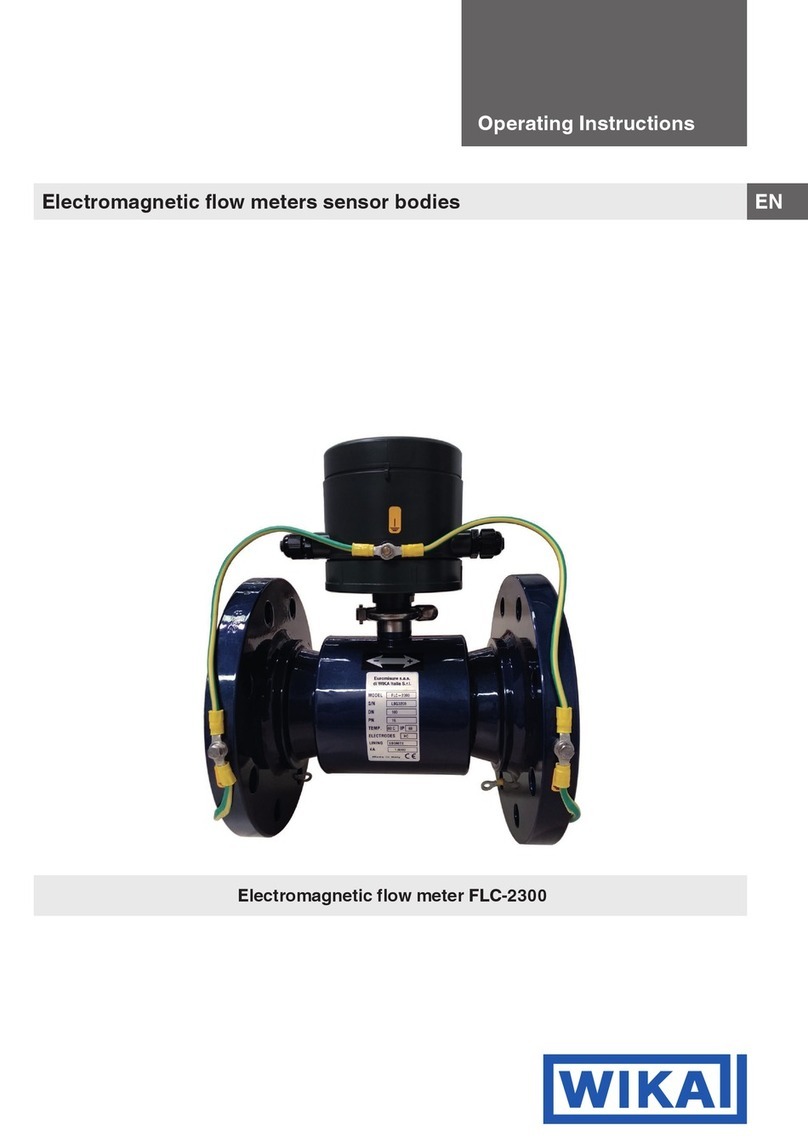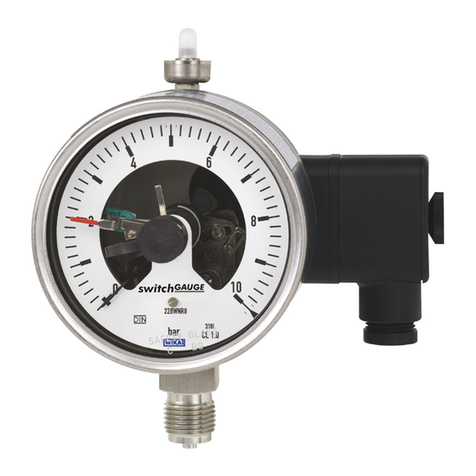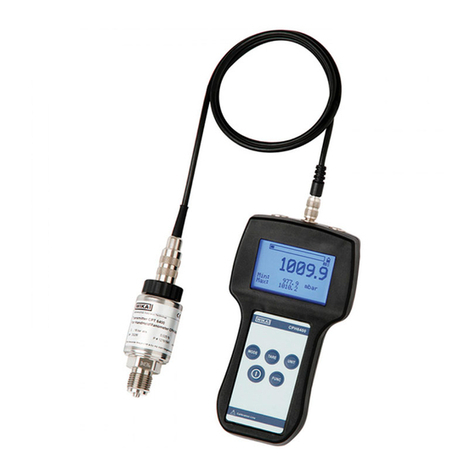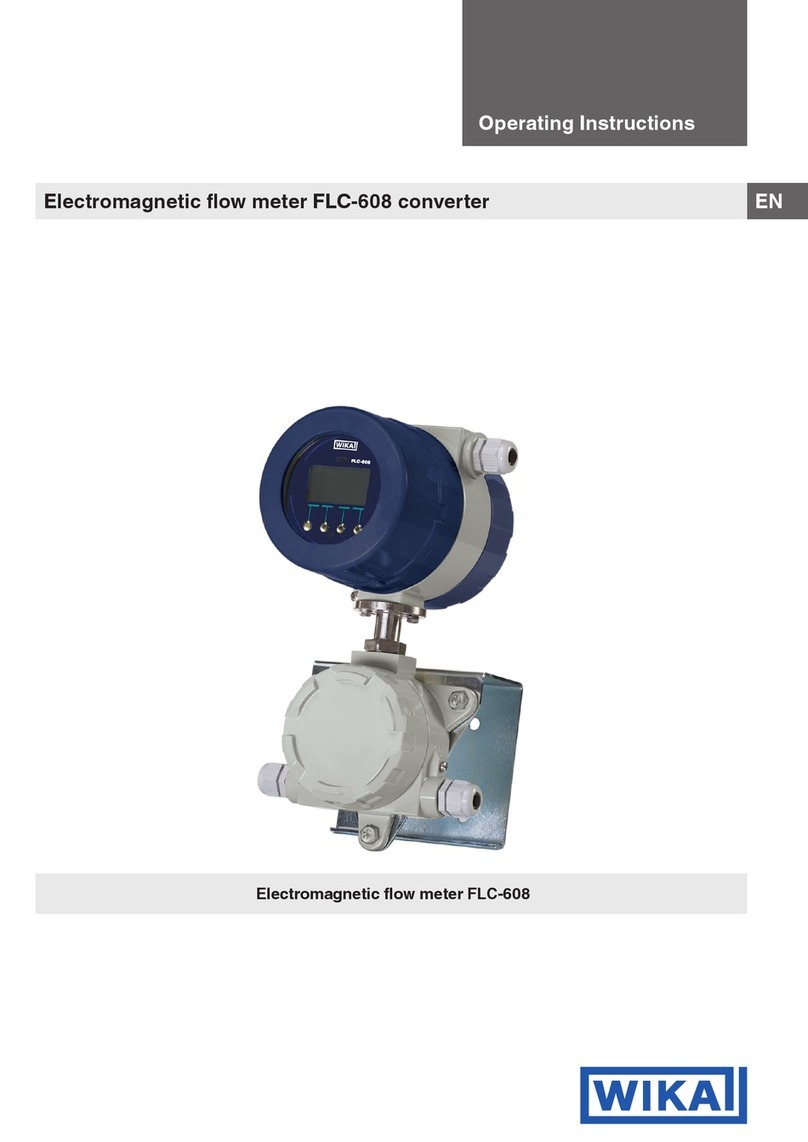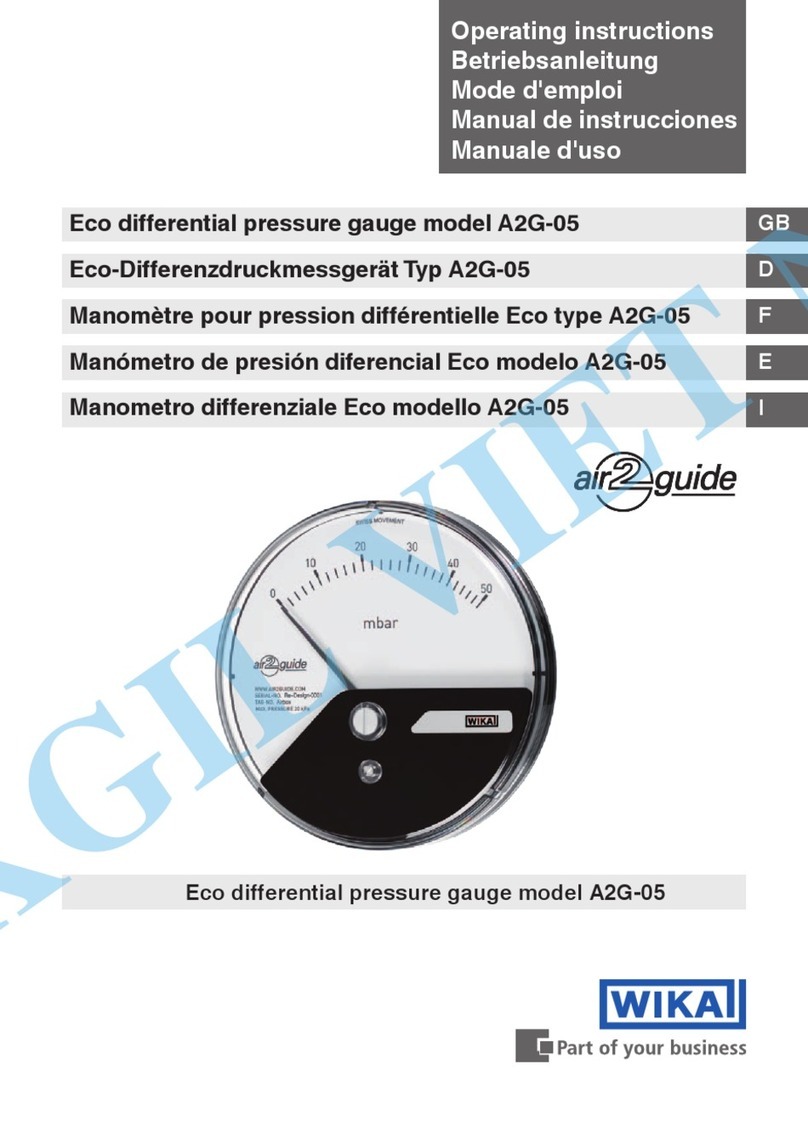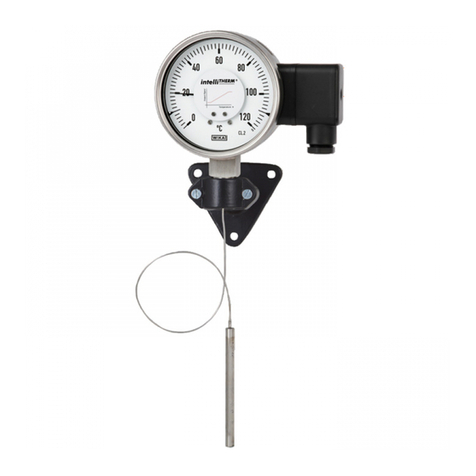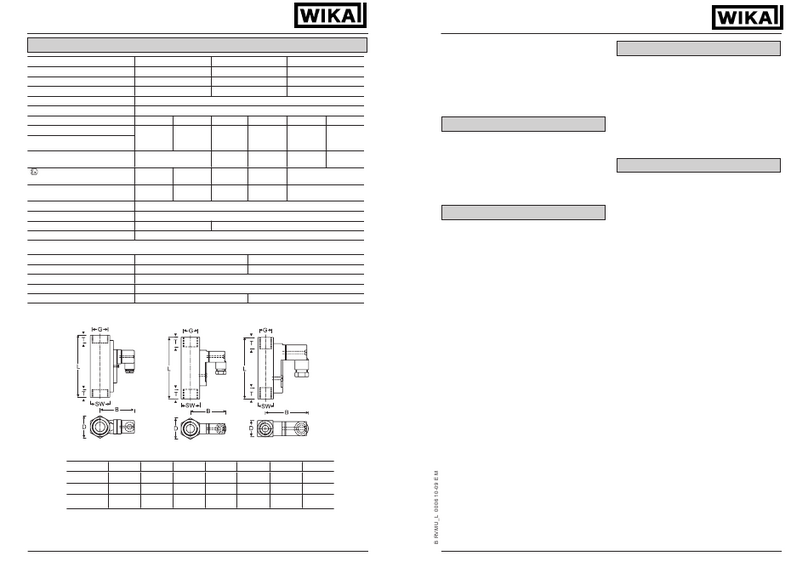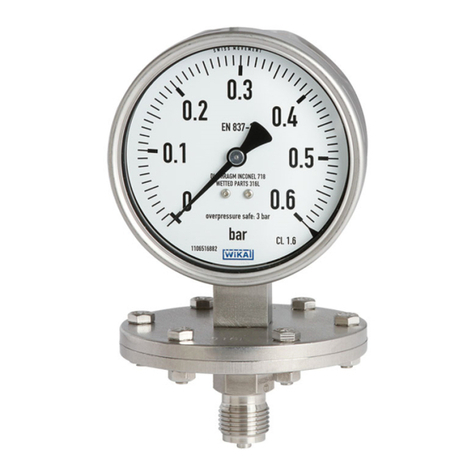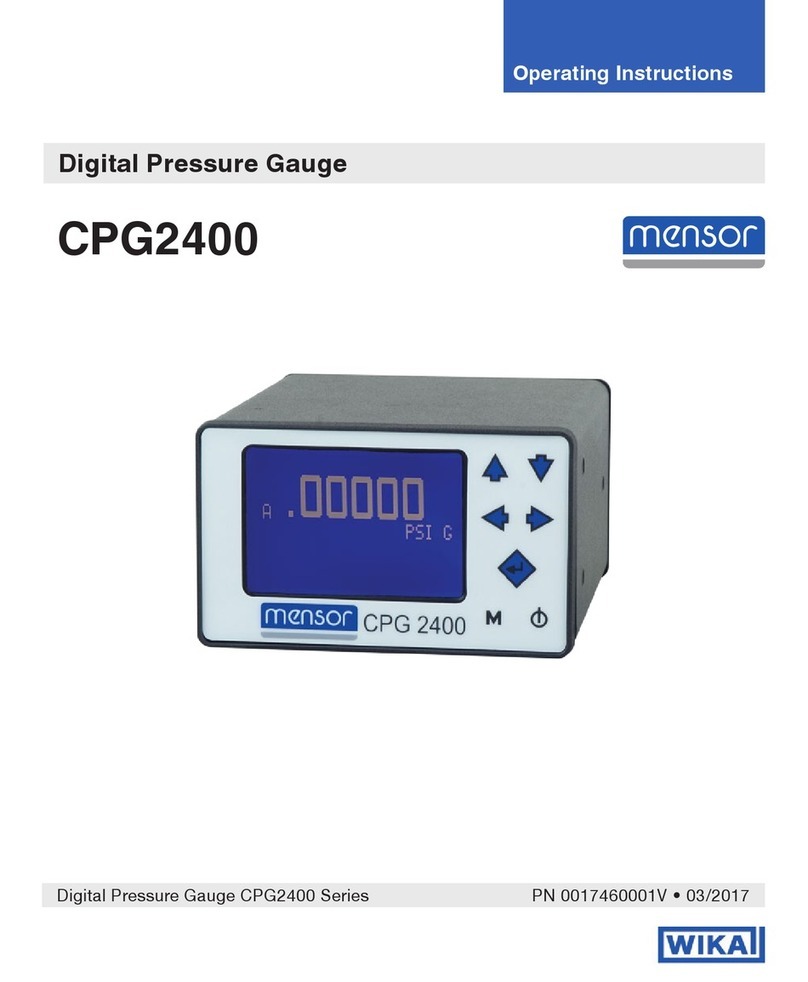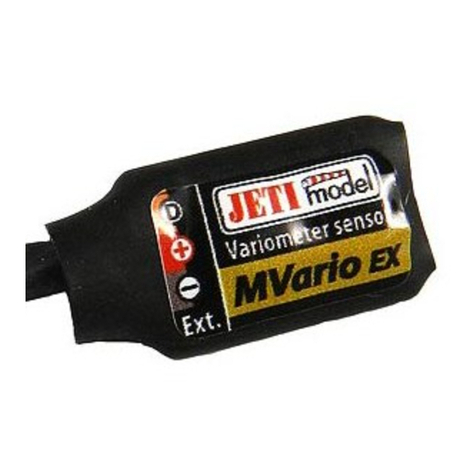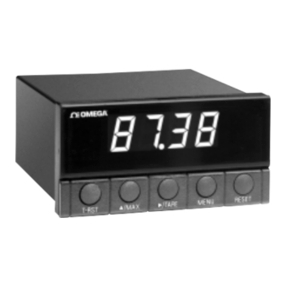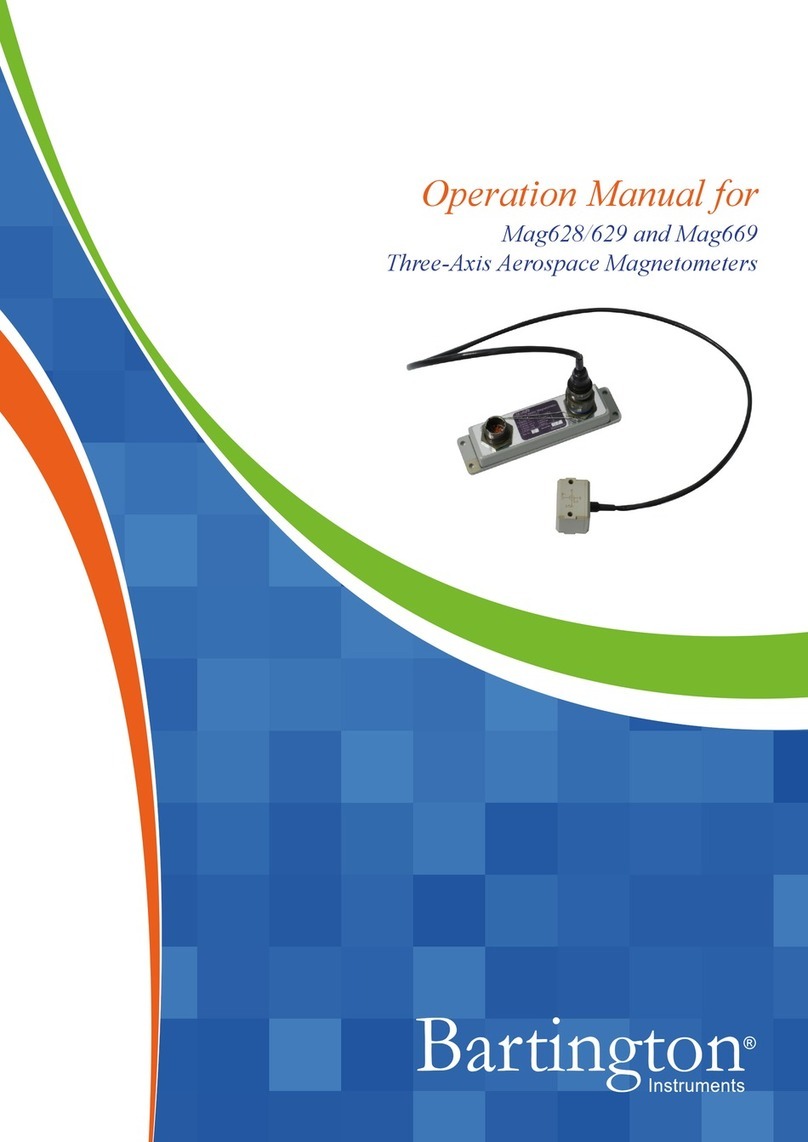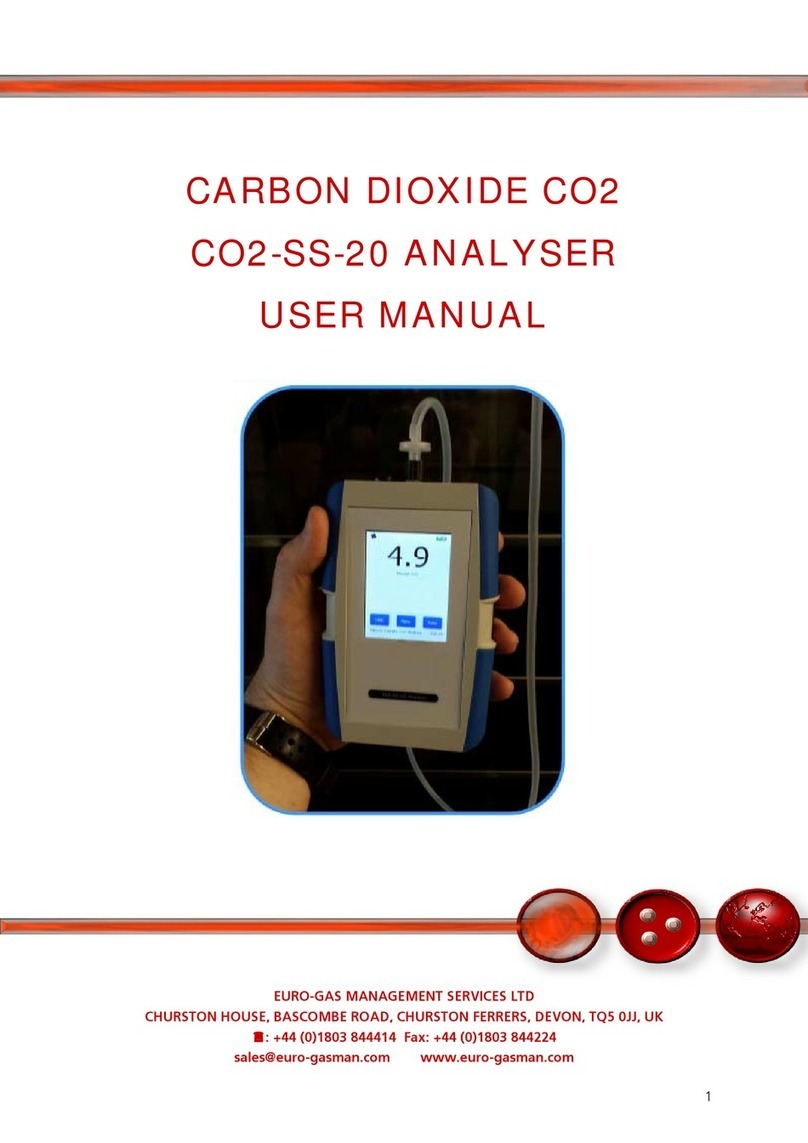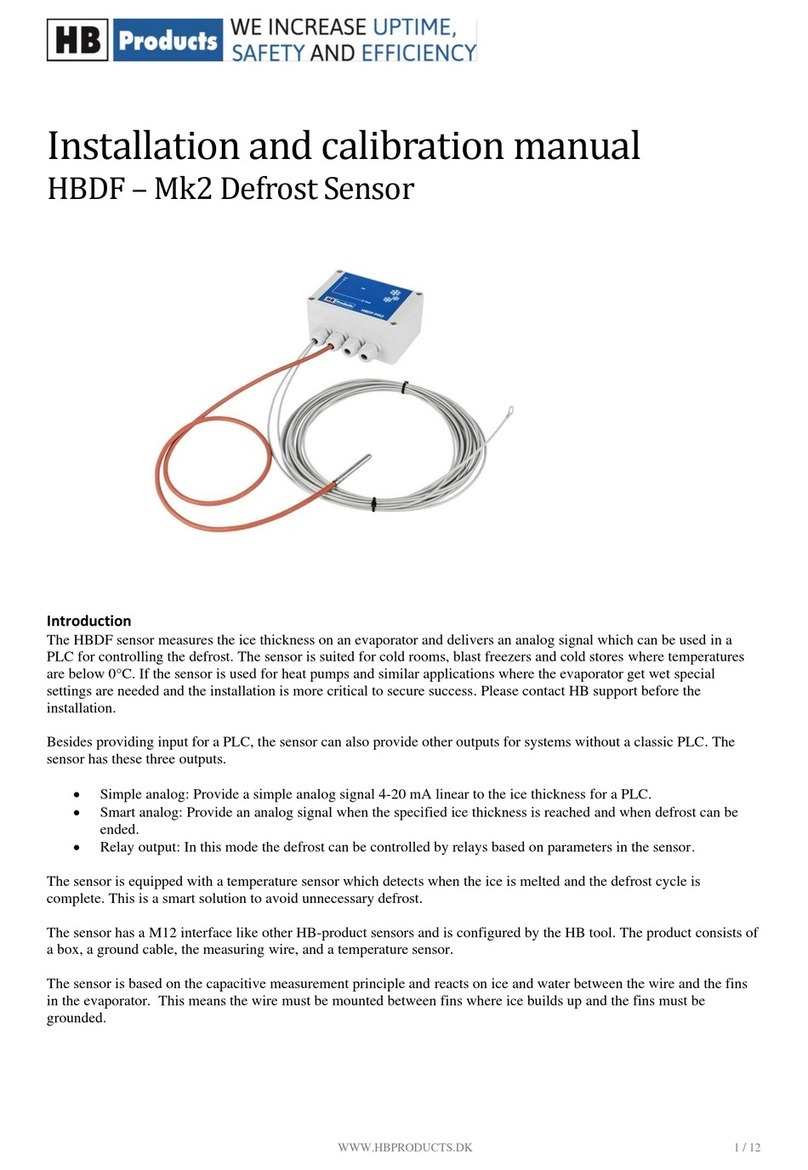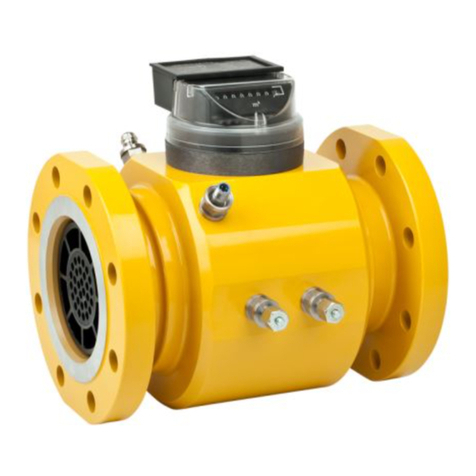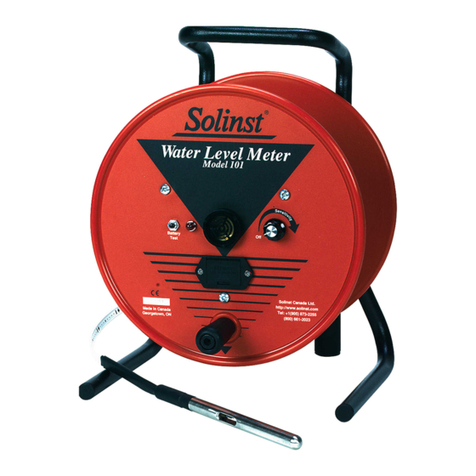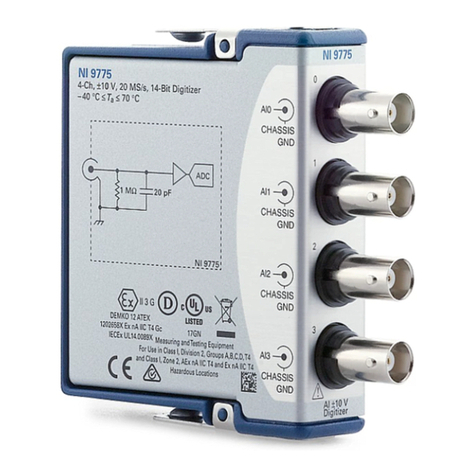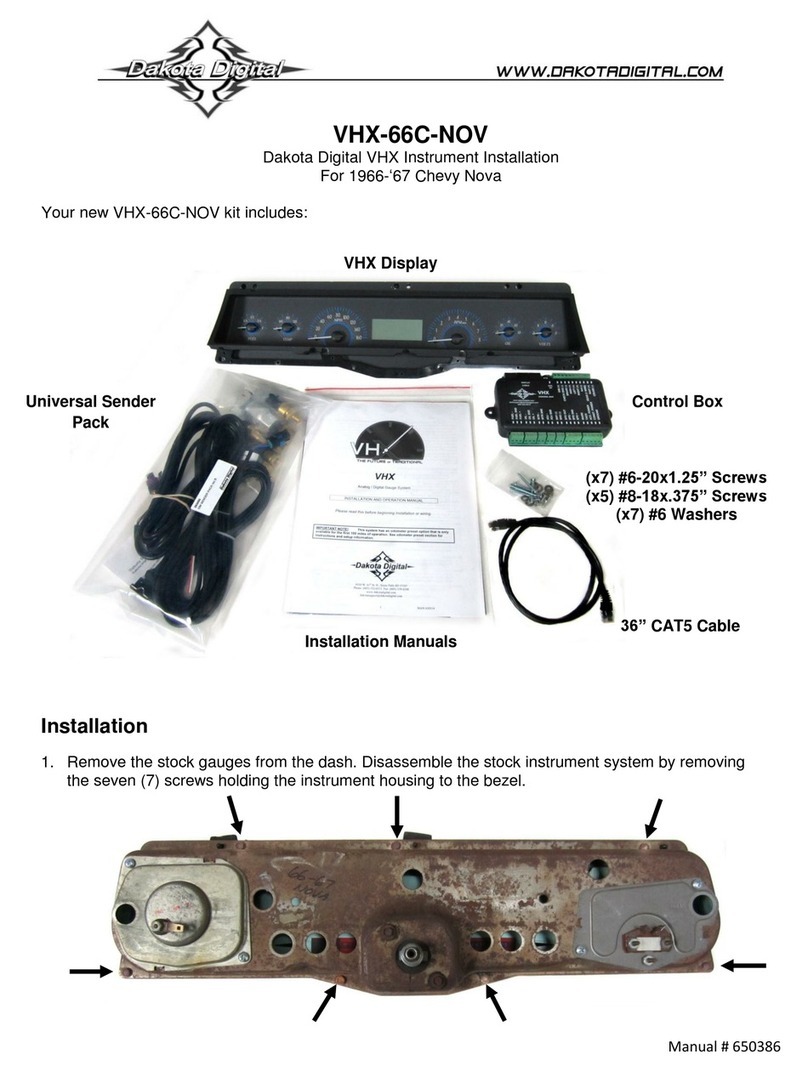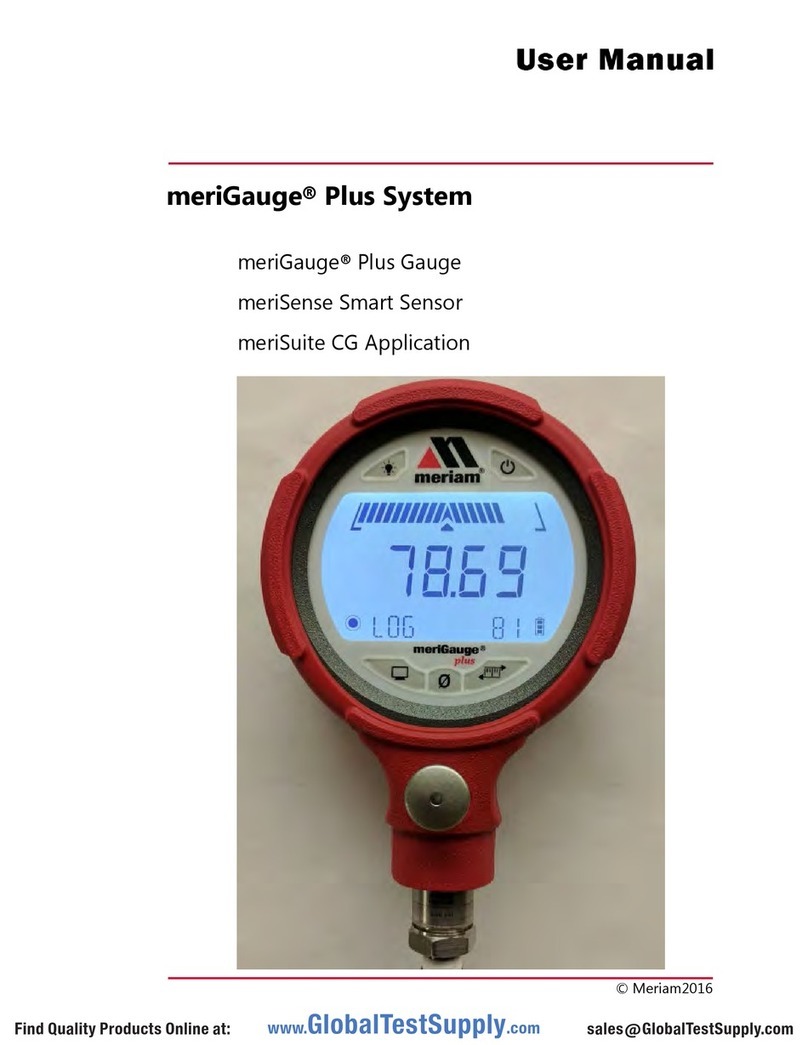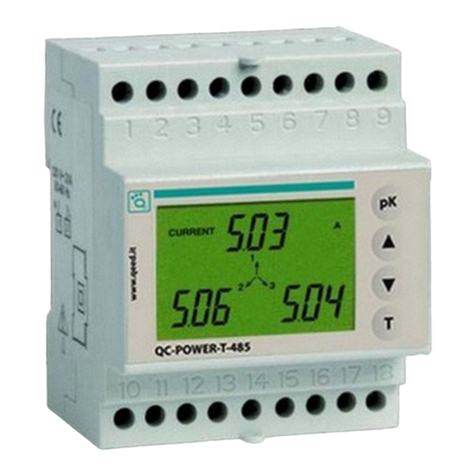WIKA PG81 User manual

Operating instructions
Betriebsanleitung
Mode d'emploi
Manual de instrucciones
EN
DE
FR
ES
Pressure gauges DirectDrive version,
models PG81 and PG91
Manometer DirectDrive-Ausführung,
Typen PG81 und PG91
Manomètres version DirectDrive,
types PG81 et PG91
Manómetros versión DirectDrive,
modelos PG81 y PG91
Model PG81 Model PG91

2
14381555.01 07/2022 DE/EN/FR/ES
WIKA operating instructions models PG81 and PG91
EN
DE
FR
ES
© 07/2022 WIKA Alexander Wiegand SE & Co. KG
All rights reserved. / Alle Rechte vorbehalten.
WIKA®is a registered trademark in various countries.
WIKA®ist eine geschützte Marke in verschiedenen Ländern.
Prior to starting any work, read the operating instructions!
Keep for later use!
Vor Beginn aller Arbeiten Betriebsanleitung lesen!
Zum späteren Gebrauch aufbewahren!
Lire le mode d‘emploi avant de commencer toute opération !
A conserver pour une utilisation ultérieure !
¡Leer el manual de instrucciones antes de comenzar cualquier trabajo!
¡Guardar el manual para una eventual consulta!
Operating instructions models PG81 and PG91 Page 3 - 16
Betriebsanleitung Typen PG81 und PG91 Seite 17 - 30
Mode d'emploi types PG81 et PG91 Page 31 - 44
Manual de instrucciones modelos PG81 y PG91 Página 45 - 58

3WIKA operating instructions models PG81 and PG91
14381555.01 07/2022 DE/EN/FR/ES
EN
Contents
Contents
Declarations of conformity can be found online at www.wika.com.
1. General information 4
2. Design and function 5
3. Safety 6
4. Transport, packaging and storage 9
5. Commissioning, operation 10
6. Faults 11
7. Maintenance and cleaning 12
8. Dismounting, return and disposal 13
9. Specifications 15

4WIKA operating instructions models PG81 and PG91
14381555.01 07/2022 DE/EN/FR/ES
EN
1. General information
■The pressure gauge described in the operating instructions has been designed and
manufactured using state-of-the-art technology. All components are subject to strin-
gent quality and environmental criteria during production. Our management systems
are certified to ISO 9001 and ISO 14001.
■These operating instructions contain important information on handling the instru-
ment. Working safely requires that all safety instructions and work instructions are
observed.
■Observe the relevant local accident prevention regulations and general safety regula-
tions for the instrument's range of use.
■The operating instructions are part of the product and must be kept in the immediate
vicinity of the instrument and readily accessible to skilled personnel at any time. Pass
the operating instructions on to the next operator or owner of the instrument.
■Skilled personnel must have carefully read and understood the operating instructions
prior to beginning any work.
■The general terms and conditions contained in the sales documentation shall apply.
■Subject to technical modifications.
■Further information:
- Internet address: www.wika.de / www.wika.com
- Relevant data sheet: PM 01.50
- Application consultant: Tel.: +49 9372 132-0
Fax: +49 9372 132-406
info@wika.de
1. General information

5WIKA operating instructions models PG81 and PG91
14381555.01 07/2022 DE/EN/FR/ES
EN
2. Design and function
2. Design and function
2.1 Overview
Dial with pressure scale and, if necessary, further individual markings
Pointer
Window
Blow-out device 1) with pressure compensation film 2)
Case
Process connection
1) prevents the ejection of the window in the event of a sudden pressure increase in the case
2) protects against the ingress of dust and water into the case
2.2 Description
The models PG81 and PG91 are DirectDrive pressure gauges.The pointer is thus
displaced directly by the pressure element without a movement or the pointer itself is
the pressure element.The model PG81 is a DirectDrive pressure gauge with spiral tube
design and the model PG91 is with a helical tube design. In comparison with a traditio-
nal pressure gauge, the vibration and shock resistance of the model is increased and, in
addition, a particularly flat design is enabled.
2.3 Scope of delivery
Cross-check scope of delivery with delivery note.

6WIKA operating instructions models PG81 and PG91
14381555.01 07/2022 DE/EN/FR/ES
EN
3. Safety
3.1 Explanation of symbols
WARNING!
... indicates a potentially dangerous situation that can result in serious
injury or death, if not avoided.
CAUTION!
... indicates a potentially dangerous situation that can result in light injuries
or damage to property or the environment, if not avoided.
WARNING!
... indicates a potentially dangerous situation that can result in burns,
caused by hot surfaces or liquids, if not avoided.
Information
... points out useful tips, recommendations and information for efficient
and trouble-free operation.
3.2 Intended use
The pressure gauges in DirectDrive design should be used exclusively for measuring
static pressures in dry, gaseous, not highly viscous and non-crystallising media that will
not attack copper alloy parts.The process connection and the measuring line must be
dry and free from foreign bodies. Avoid rapid and frequent load cycles.
The scope of application is defined by the technical performance limits and materials.
The pressure gauges have been designed for industrial applications in indoor and
outdoor areas.This instrument is no “safety accessory”.
Maximum pressure limitation
■Steady: 3/4 x full scale value (corresponds in further course to the described max.
permissible operating pressure, marked by “PS”)
■Short time: Full scale value of the pressure scale
Permissible temperature ranges
■Ambient: -20 … +65 °C
■Medium: -20 … +65 °C
■Storage: -40 … +70 °C
3. Safety

7WIKA operating instructions models PG81 and PG91
14381555.01 07/2022 DE/EN/FR/ES
EN
Ingress protection
IP65 per EN/lEC 60529
For further specifications see WIKA data sheet PM 01.50, the order documentation and
chapter 9 “Specifications”.
The instrument has been designed and built solely for the intended use described here,
and may only be used accordingly.
The manufacturer shall not be liable for claims of any type based on operation contrary
to the intended use.
Any operation of the instruments deviating from the above provisions must be clearly
discussed, tested and approved in advance in detail with the responsible technical
department of the manufacturer.
Improper use
WARNING!
Injuries through improper use
Improper use of the instrument can lead to hazardous situations and
injuries.
▶Refrain from unauthorised modifications to the instrument.
▶Do not use the instrument within hazardous areas.
▶Do not use the instrument with abrasive or viscous media.
▶Only operate the instrument in the specified pressure and temperature
range.
▶Do not block the blow-out device on the back of the case.
Improper use is defined as any application that exceeds the technical performance
limits or is not compatible with the materials. Checking against improper use is the
responsibility of the operator.
Any permanent operation in the overload range is not permitted. Over the highest
permissible operating pressure up to the overload limit, the models PG81 and PG91
operate outside their specifications.The overload range is intended to prevent damage
to the models PG81 and PG91, as part of a pressure vessel system, during the pressure
containment test.
The overload limit must never be exceeded, even when failures occur in the end-use
application. Loads above the overload limit can cause irreversible damage, which can
lead, for example, to permanent measuring errors.
Any permissible operating conditions (e.g. pressure and temperature ranges, environ-
mental influences, shock or vibration) must be observed.
3. Safety

8WIKA operating instructions models PG81 and PG91
14381555.01 07/2022 DE/EN/FR/ES
EN
3.3 Responsibility of the operator
The instrument should only be used in industrial applications.The operator is therefore
responsible for legal obligations regarding safety at work.
The safety instructions within these operating instructions, as well as the safety,
accident prevention and environmental protection regulations for the application area
must be maintained.
To ensure safe working on the instrument, the operating company must ensure the
following.
■First aiders and first-aid equipment must be available at all times in case they are
needed.
■The operating personnel must be regularly instructed in all topics regarding work
safety, first aid and environmental protection. Ensure that the operating instructions
and, in particular, the safety instructions contained therein are known.
■The suitability of the instrument in accordance with its intended use must be tested
for the particular application.
■Personal protective equipment must be provided.
3.4 Personnel qualification
WARNING!
Risk of injury should qualification be insufficient
Improper handling can result in considerable injury and damage to property.
▶The activities described in these operating instructions may only be
carried out by skilled personnel who have the qualifications described
below.
Skilled personnel
Skilled personnel, authorised by the operator, are understood to be personnel who,
based on their technical training, knowledge of measurement and control technolo-
gy and on their experience and knowledge of country-specific regulations, current
standards and directives, are capable of carrying out the work described and indepen-
dently recognising potential hazards.
3.5 Personal protective equipment
The personal protective equipment is designed to protect the skilled personnel from
hazards that could impair their safety or health during work. When carrying out the
various tasks on and with the instrument, the skilled personnel must wear personal
protective equipment.
Follow the instructions displayed in the work area regarding personal protective equipment!
3. Safety

9WIKA operating instructions models PG81 and PG91
14381555.01 07/2022 DE/EN/FR/ES
EN
The requisite personal protective equipment must be provided by the operating company.
Wear safety goggles!
Protect eyes from flying particles and liquid splashes.
Wear protective gloves!
Protect hands from friction, abrasion, cuts or deep injuries and also from
contact with hot surfaces and aggressive media.
3.6 Dial layout (example)
Pressure scale and optional secondary scale Pressure unit
CE marking (only PS ≥ 200 bar) and,
if required, further approval marks
Specification of max. operating pressure
“PS”
Company logo and model designation Surface for marking,
e.g.“oil and grease free”
3. Safety

10 WIKA operating instructions models PG81 and PG91
14381555.01 07/2022 DE/EN/FR/ES
EN
4. Transport, packaging and storage
4.1 Transport
Check the instrument and the transport container for any damage that may have been
caused by transport.
Obvious damage must be reported immediately.
CAUTION!
Damage through improper transport
With improper transport, a high level of damage to property can occur.
▶When unloading packed goods upon delivery as well as during inter-
nal transport, proceed carefully and observe the symbols on the
packaging.
▶With internal transport, observe the instructions in chapter 4.2
“Packaging and storage”.
4.2 Packaging and storage
Do not remove packaging until just before mounting.
Keep the packaging as it will provide optimum protection during transport (e.g. change
in installation site, sending for repair).
Permissible conditions at the place of storage
Storage temperature: -40 ... +70 °C
Avoid exposure to the following factors
■Direct sunlight or proximity to hot objects
■Mechanical vibration, mechanical shock (putting it down hard)
■Soot, vapour, dust and corrosive gases
■Hazardous environments, flammable atmospheres
Store the instrument in its original packaging in a location that fulfils the conditions listed
above. If the original packaging is not available, please contact WIKA.
4. Transport, packaging and storage

11WIKA operating instructions models PG81 and PG91
14381555.01 07/2022 DE/EN/FR/ES
EN
5. Commissioning, operation
Personnel: Skilled personnel
Protective equipment: Safety goggles, protective gloves
Tools: Open-ended spanner
WARNING!
Physical injuries and damage to property and the environment
caused by hazardous media
Upon contact with hazardous media (e.g. oxygen, acetylene, flammable or
toxic substances), harmful media (e.g. corrosive, toxic, carcinogenic, radio-
active), and also with refrigeration plants or compressors, there is a danger
of physical injuries and damage to property and the environment.
Aggressive media with extremely high temperatures and under high
pressure or vacuum may be present at the instrument. In the event of failu-
re, components can be ejected or media exhausted under high pressure.
▶For these media, in addition to all standard regulations, the appropriate
existing codes or regulations must also be followed.
▶Wear the requisite protective equipment (see chapter 3.5 “Personal
protective equipment”).
5.1 Requirements for the installation location
For internal and external operation. Protect the instrument from direct sunlight.
5.2 Mechanical connection
■Follow the general technical regulations for pressure measuring instruments (e.g.
EN 837-2 “Selection and installation recommendations for pressure gauges”).
■It must be ensured that the process connection of the system is not pressurised
during fitting and dismounting of the pressure gauge.
■If the pressure gauge is mounted lower than the pressure tapping point, the
measuring line must be cleaned thoroughly before connection in order to clear out
any foreign matter. Before fitting, all measuring lines must be dry.
■When screwing the instruments in, the force required for sealing must not be applied
through the case, but only through the spanner flats provided for this purpose at the
connection shank, and using a suitable tool.
Spanner flats
Sealing face
Sealing in the
thread
Installation with open-ended spanner Sealing of the process connection
5. Commissioning, operation

12 WIKA operating instructions models PG81 and PG91
14381555.01 07/2022 DE/EN/FR/ES
EN
For sealing the pressure gauge connections with parallel threads, use flat gaskets, lens-
type sealing rings or WIKA profile sealings at the sealing face . With a tapered thread
(e.g. NPT thread), sealing is made in the thread using additional sealing materials,
e.g. PTFE tape (EN 837-2).
The torque depends on the sealing used. In order to orientate the measuring instrument
so that it can be read as well as possible, a connection with LH-RH union or union nut
should be used.
6. Faults
CAUTION!
Physical injuries and damage to property and the environment
If faults cannot be eliminated by means of the listed measures, the instru-
ment must be taken out of operation immediately.
▶Ensure that pressure or signal is no longer present and protect against
accidental commissioning.
▶Contact the manufacturer.
▶If a return is needed, please follow the instructions given in chapter 8.2
“Return”.
WARNING!
Physical injuries and damage to property and the environment
caused by hazardous media
Upon contact with hazardous media (e.g. oxygen, acetylene, flammable
or toxic substances), harmful media (e.g. corrosive, toxic, carcinogenic,
radioactive), and also with refrigeration plants or compressors, there is a
danger of physical injuries and damage to property and the environment.
Should a failure occur, aggressive media with extremely high temperature
and under high pressure or vacuum may be present at the instrument.
▶For these media, in addition to all standard regulations, the appropriate
existing codes or regulations must also be followed.
▶Wear the requisite protective equipment (see chapter 3.5 “Personal
protective equipment”).
Fault Cause Measure
Indication error Inadmissible operating
conditions, e.g. exceeding
the pressure limitation
Replace pressure gauge, see
chapter 8 “Dismounting, return
and disposal”
Window misted up on the
inside
Pressure compensation
film on the case back has
come loose
Replace pressure gauge, see
chapter 8 “Dismounting, return
and disposal”
Functionality of the
'as-delivered' condition is no
longer fulfilled
Transport damage Return to the manufacturer
5. Commissioning, operation / 6. Faults

13WIKA operating instructions models PG81 and PG91
14381555.01 07/2022 DE/EN/FR/ES
EN
7. Maintenance and cleaning
Personnel: Skilled personnel
Protective equipment: Safety goggles, protective gloves
7.1 Maintenance
This pressure gauge is maintenance-free. Defective instruments must be replaced by
new instruments immediately.
7.2 Cleaning
CAUTION!
Physical injuries and damage to property and the environment
Improper cleaning may lead to physical injuries and damage to property
and the environment. Residual media in the dismounted instrument can
result in a risk to persons, the environment and equipment.
▶Carry out the cleaning process as described below.
CAUTION!
Damage to the instrument
Improper cleaning may lead to damage to the instrument!
▶Do not use any aggressive cleaning agents.
▶Do not use any hard or pointed objects for cleaning.
1. Before cleaning, correctly disconnect the instrument from the pressure supply.
2. Use the requisite protective equipment.
3. Clean the instrument with a moist cloth.
7. Maintenance and cleaning

14 WIKA operating instructions models PG81 and PG91
14381555.01 07/2022 DE/EN/FR/ES
EN
8. Dismounting, return and disposal
Personnel: Skilled personnel
Protective equipment: Safety goggles, protective gloves
Tool: Open-ended spanner
WARNING!
Physical injuries and damage to property and the environment
through residual media
Upon contact with hazardous media (e.g. oxygen, acetylene, flammable
or toxic substances), harmful media (e.g. corrosive, toxic, carcinogenic,
radioactive), and also with refrigeration plants and compressors, there is a
danger of physical injuries and damage to property and the environment.
▶Before storage of the dismounted instrument (following use) wash or
clean it, in order to protect persons and the environment from exposure
to residual media.
▶Wear the requisite protective equipment (see chapter 3.5 “Personal
protective equipment”).
WARNING!
Risk of burns
During dismounting there is a risk of dangerously hot media escaping.
▶Let the instrument cool down sufficiently before dismounting it!
WARNING!
Physical injury
When dismounting, there is a danger from aggressive media and high
pressures.
▶Wear the requisite protective equipment (see chapter 3.5 “Personal
protective equipment”).
▶Observe the information in the material safety data sheet for the corres-
ponding medium.
▶Disconnect the pressure gauge once the system has been depressu-
rised!
8.1 Dismounting
1. Before dismounting, make sure that the measuring point is not pressurised and has
cooled down.
2. Dismount the pressure gauge with an open-ended spanner using the spanner flats
of the process connection
8. Dismounting, return and disposal

15WIKA operating instructions models PG81 and PG91
14381555.01 07/2022 DE/EN/FR/ES
EN
8.2 Return
Strictly observe the following when shipping the instrument:
All instruments delivered to WIKA must be free from any kind of hazardous substances
(acids, bases, solutions, etc.) and must therefore be cleaned before being returned.
WARNING!
Physical injuries and damage to property and the environment
through residual media
Residual media in the dismounted instrument can result in a risk to
persons, the environment and equipment.
▶With hazardous substances, include the material safety data sheet for
the corresponding medium.
▶Clean the instrument, see chapter 7.2 “Cleaning”.
Cleaning for return
If the instruments are free from hazardous materials, it does not make sense
to clean them thoroughly in the event of a return since the media may be
relevant to the failure analysis.
When returning the instrument, use the original packaging or a suitable transport
packaging.
Information on returns can be found under the heading “Service” on our
local website.
8.3 Disposal
Incorrect disposal can put the environment at risk.
Dispose of instrument components and packaging materials in an environmentally
compatible way and in accordance with the country-specific waste disposal regulations.
8. Dismounting, return and disposal

16 WIKA operating instructions models PG81 and PG91
14381555.01 07/2022 DE/EN/FR/ES
EN
9. Specifications
Specifications
Nominal size in mm (NS) 36, 41
Accuracy class1) 4.0 (5.0 with pressure range ≤12 bar)
Maximum pressure limitation
Steady 3/4 x full scale value (marked by “PS”)
Short time Full scale value
Permissible temperature range
Ambient -20 … +65 °C
Medium -20 … +65 °C
Storage -40 … +70 °C
Temperature effect max. ±0.4 %/10 K of the span
When the temperature of the measuring system deviates
from the reference temperature (+20 °C)
Ingress protection per
EN/lEC 60529
■IP65
■IP67
Process connection
Material Copper alloy
Connection location Centre back mount
Connection G ¼ B, SW 14
Pressure element Copper alloy, spiral and helical form
Dial Aluminium, white, black lettering
Indication angle 160 ° ±15° (standard)
Pointer Copper alloy, black
Case Stainless steel
Window Polycarbonate, clear
1) Including non-linearity, hysteresis, zero offset and end value deviation (corresponds to measured error per
IEC 61298-2). Adjusted at nominal position per EN 837-1.
9. Specifications

17WIKA Betriebsanleitung Typen PG81 und PG91
DE
14381555.01 07/2022 DE/EN/FR/ES
Inhalt
Inhalt
Konformitätserklärungen finden Sie online unter www.wika.de.
1. Allgemeines 18
2. Aufbau und Funktion 19
3. Sicherheit 20
4. Transport, Verpackung und Lagerung 23
5. Inbetriebnahme, Betrieb 24
6. Störungen 25
7. Wartung und Reinigung 26
8. Demontage, Rücksendung und Entsorgung 27
9. Technische Daten 29

18 WIKA Betriebsanleitung Typen PG81 und PG91
DE
14381555.01 07/2022 DE/EN/FR/ES
1. Allgemeines
1. Allgemeines
■Das in der Betriebsanleitung beschriebene Manometer wird nach dem aktuellen
Stand der Technik konstruiert und gefertigt. Alle Komponenten unterliegen während
der Fertigung strengen Qualitäts- und Umweltkriterien. Unsere Managementsysteme
sind nach ISO 9001 und ISO 14001 zertifiziert.
■Diese Betriebsanleitung gibt wichtige Hinweise zum Umgang mit dem Gerät.
Voraussetzung für sicheres Arbeiten ist die Einhaltung aller angegebenen
Sicherheitshinweise und Handlungsanweisungen.
■Die für den Einsatzbereich des Gerätes geltenden örtlichen
Unfallverhütungsvorschriften und allgemeinen Sicherheitsbestimmungen einhalten.
■Die Betriebsanleitung ist Produktbestandteil und muss in unmittelbarer Nähe des
Gerätes für das Fachpersonal jederzeit zugänglich aufbewahrt werden. Betriebsan-
leitung an nachfolgende Benutzer oder Besitzer des Gerätes weitergeben.
■Das Fachpersonal muss die Betriebsanleitung vor Beginn aller Arbeiten sorgfältig
durchgelesen und verstanden haben.
■Es gelten die allgemeinen Geschäftsbedingungen in den Verkaufsunterlagen.
■Technische Änderungen vorbehalten.
■Weitere Informationen:
- Internet-Adresse: www.wika.de / www.wika.com
- Zugehöriges Datenblatt: PM 01.50
- Anwendungsberater: Tel.: +49 9372 132-0
Fax: +49 9372 132-406
info@wika.de

19WIKA Betriebsanleitung Typen PG81 und PG91
DE
14381555.01 07/2022 DE/EN/FR/ES
2. Aufbau und Funktion
2. Aufbau und Funktion
2.1 Überblick
Zifferblatt mit Druckskale und ggf. weiteren individuellen Kennzeichnungen
Zeiger
Sichtscheibe
Entlastungsöffnung
1)
mit Druckausgleichsfolie
2)
Gehäuse
Prozessanschluss
1) verhindert das Herausschleudern der Sichtscheibe im Falle eines schlagartigen Druckanstiegs im Gehäuse
2) schützt vor Eindringen von Staub und Wasser in das Gehäuse
2.2 Beschreibung
Die Typen PG81 und PG91 sind DirectDrive-Manometer. Der Zeiger wird dabei ohne
Zeigerwerk direkt vom Messglied bewegt oder ist das Messglied selbst. Der Typ PG81
ist ein DirectDrive-Manometer mit Spiralfederbauform und der Typ PG91 mit Wendelfe-
derbauform. Im Vergleich zu einem klassischen Manometer wird zum einen die Vibra-
tions- und Schockfestigkeit des Typs erhöht und zum anderen eine besonders flache
Bauform ermöglicht.
2.3 Lieferumfang
Lieferumfang mit dem Lieferschein abgleichen.

20 WIKA Betriebsanleitung Typen PG81 und PG91
DE
14381555.01 07/2022 DE/EN/FR/ES
3. Sicherheit
3. Sicherheit
3.1 Symbolerklärung
WARNUNG!
... weist auf eine möglicherweise gefährliche Situation hin, die zum Tod
oder zu schweren Verletzungen führen kann, wenn sie nicht gemieden
wird.
VORSICHT!
... weist auf eine möglicherweise gefährliche Situation hin, die zu geringfü-
gigen oder leichten Verletzungen bzw. Sach- und Umweltschäden führen
kann, wenn sie nicht gemieden wird.
WARNUNG!
... weist auf eine möglicherweise gefährliche Situation hin, die durch heiße
Oberflächen oder Flüssigkeiten zu Verbrennungen führen kann, wenn sie
nicht gemieden wird.
Information
... hebt nützliche Tipps und Empfehlungen sowie Informationen für einen
effizienten und störungsfreien Betrieb hervor.
3.2 Bestimmungsgemäße Verwendung
Die Manometer in DirectDrive-Ausführung sind ausschließlich zur Messung statischer
Drücke bei trockenen, gasförmigen, nicht hochviskosen und nicht kristallisierenden
Messstoffen, die Kupferlegierungen nicht angreifen zu verwenden. Der Prozessan-
schluss und die Messleitung müssen trocken und frei von Fremdkörpern sein. Schnelle
und häufige Lastwechsel sind zu vermeiden.
Der Einsatzbereich ergibt sich aus den technischen Leistungsgrenzen und Werkstoffen.
Die Manometer wurden für gewerbliche Anwendungen im Innen- und Außenbereich
konzipiert. Das vorliegende Gerät ist kein „Ausrüstungsteil mit Sicherheitsfunktion“.
Maximale Druckbelastbarkeit
■Ruhebelastung: 3/4 x Skalenendwert (entspricht im weiteren Verlauf dem beschrie-
benen max. zulässigen Betriebsdruck, gekennzeichnet durch „PS“)
■Kurzzeitig: Skalenendwert der Druckskale
Zulässige Temperaturbereiche
■Umgebung: -20 … +65 °C
■Messstoff: -20 … +65 °C
■Lagerung: -40 … +70 °C
This manual suits for next models
1
Table of contents
Languages:
Other WIKA Measuring Instrument manuals

WIKA
WIKA TR Series User manual
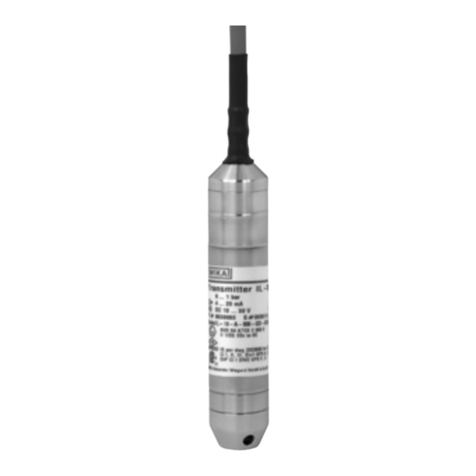
WIKA
WIKA IL-10 User manual
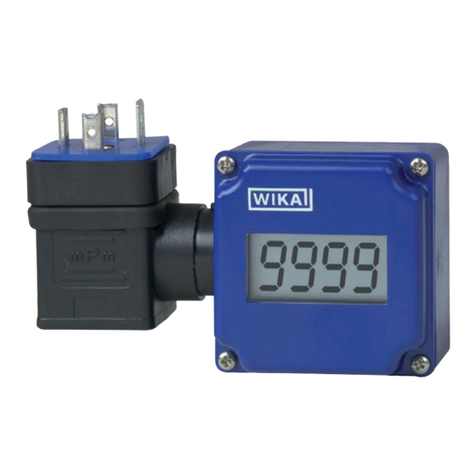
WIKA
WIKA A-AI-1 User manual
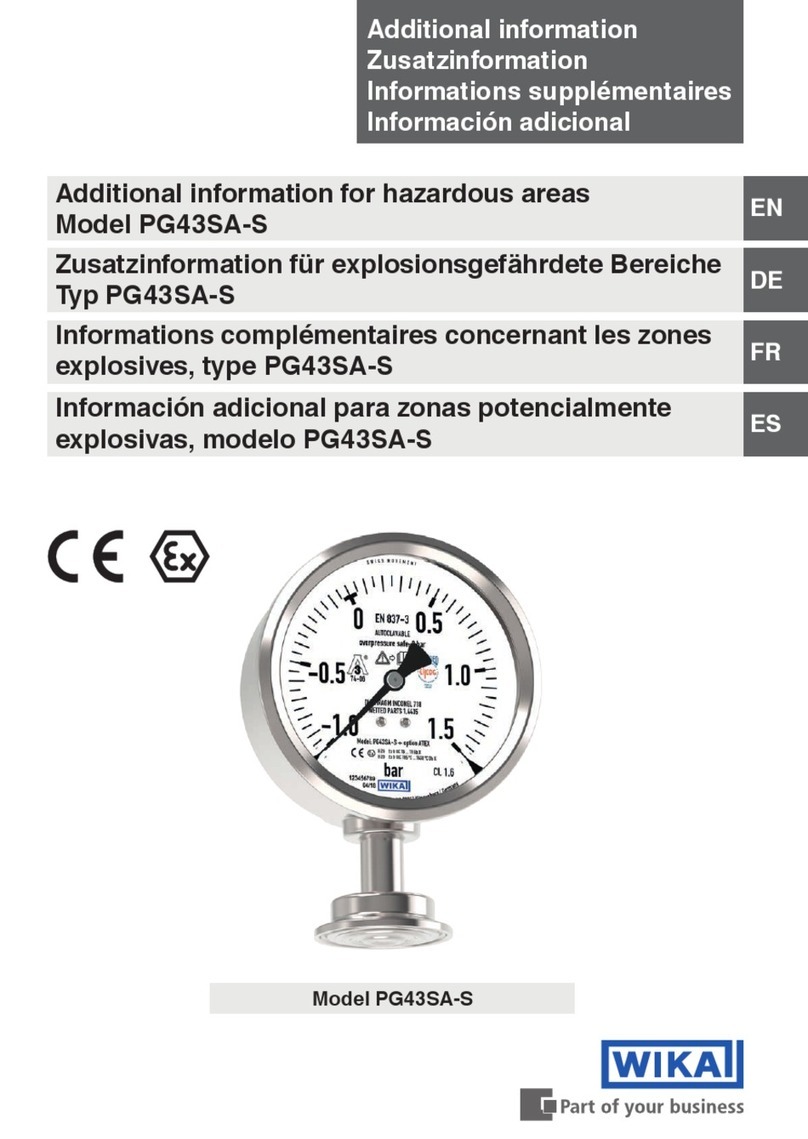
WIKA
WIKA PG43SA-S Installation manual
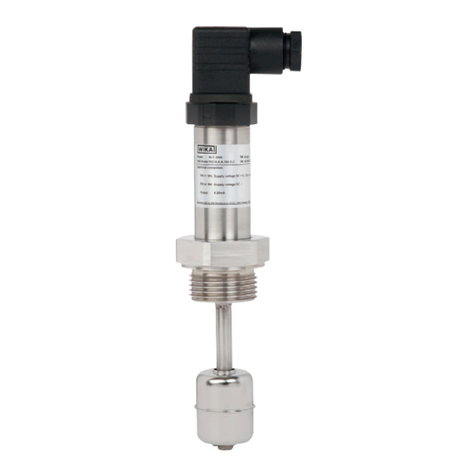
WIKA
WIKA RLT-1000 User manual

WIKA
WIKA CPH6300 User manual
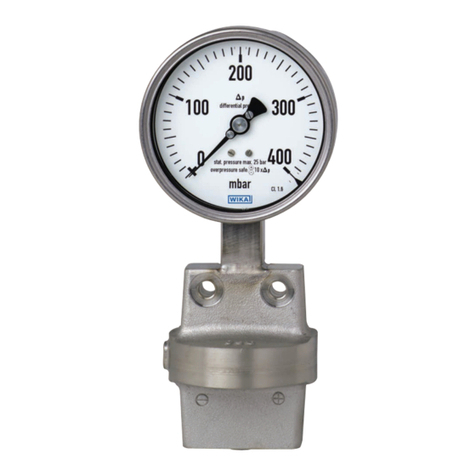
WIKA
WIKA 732.14.100 per ATEX User manual
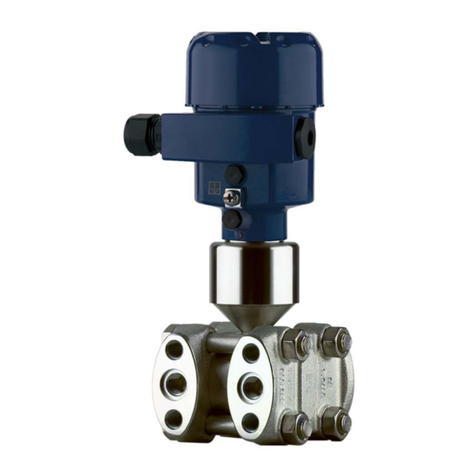
WIKA
WIKA DPT-10 User manual

WIKA
WIKA Delta-plus User manual
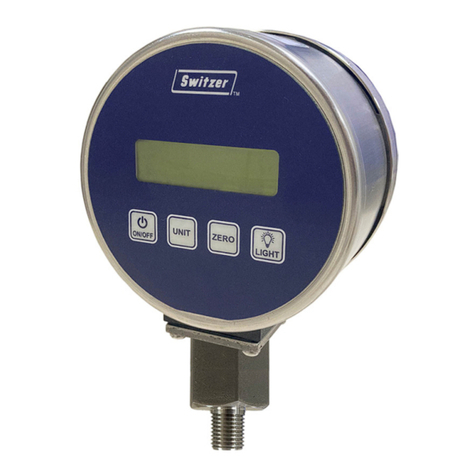
WIKA
WIKA DG-05 User manual
